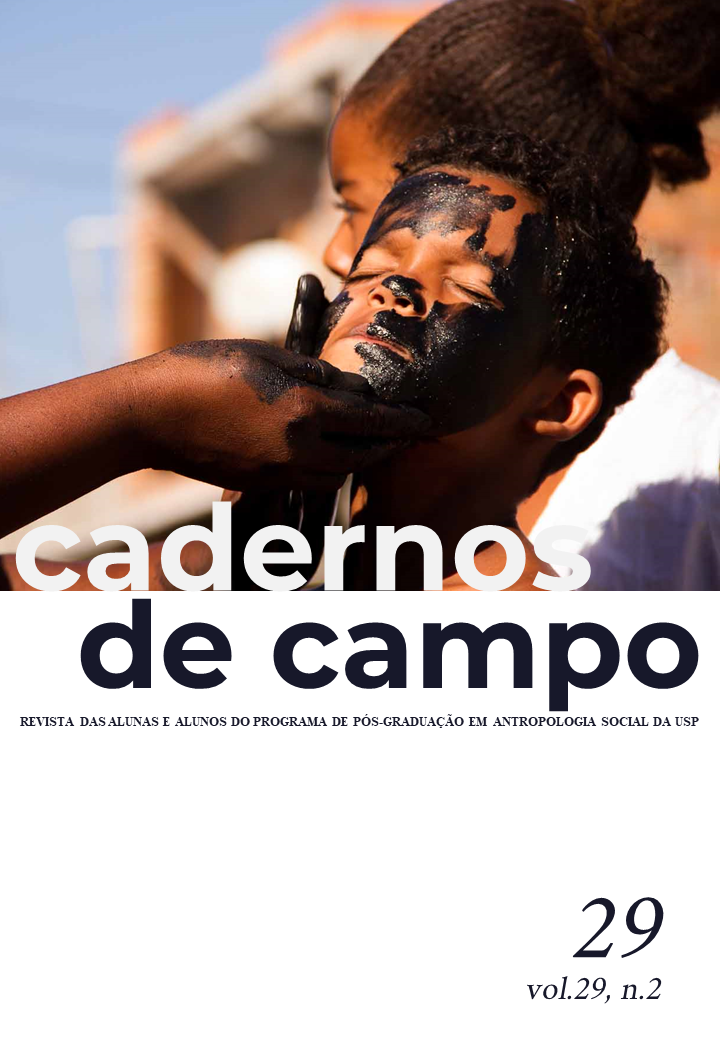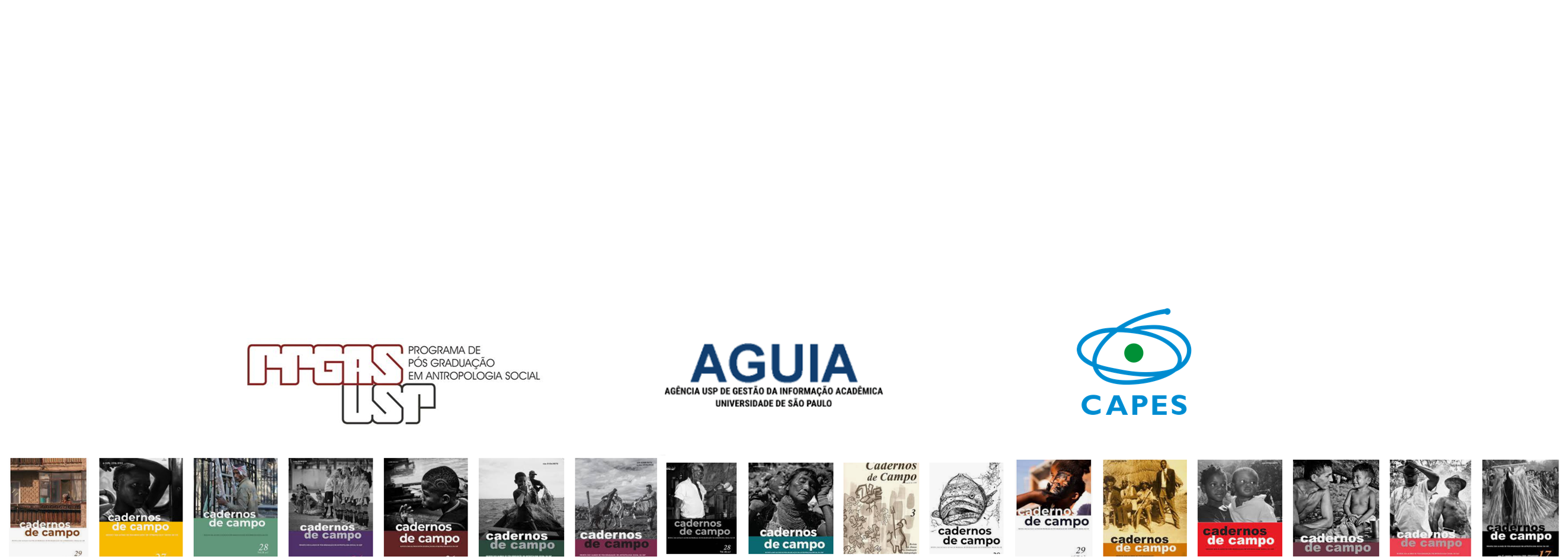A internet 3E: uma internet incorporada, corporificada e cotidiana
DOI:
https://doi.org/10.11606/issn.2316-9133.v29i2pe181370Palavras-chave:
Internet, Pesquisa digital, MetodologiasResumo
O artigo apresenta um panorama dos desafios enfrentados por etnógrafos que buscam entender atividades envolvendo a internet explorando tanto princípios metodológicos quanto estratégias práticas chegar a um acordo com a definição de sites de campo, as conexões entre online e offline e a natureza mutável da experiência corporificada. Os exemplos são extraídos de uma ampla gama de configurações, incluindo etnografias de instituições científicas, televisão, mídia social e redes locais de presentes.
Downloads
Referências
Amit, V. (ed.) (1999). Constructing the Field. London: Routledge.
Anand, N. (2011), “Pressure: the politechnics of water supply in Mumbai.” Cultural Anthropology 26(4): 542–64.
Argyle, K; Shields, R. (1996), “Is there a body in the net?” in R. Shields, Cultures of Internet: Virtual Spaces, Real Histories, Living Bodies.London: Sage: 58–69.
Arora, P. (2012), “Typology of Web 2.0 spheres: understanding the cultural dimensions of social media spaces.” Current Sociology 60(5): 599–618.
Bakardjieva, M. (2005), Internet Society: The Internet in Everyday Life. London:Sage.
Baym, N. (1995), “The emergence of community in computer-mediated communication,” in S. Jones (ed.), Cybersociety. Thousand Oaks CA: Sage: 138–63.
Jones. (2000), Tune in, Log on: Soaps, Fandom and Online Community. Thousand Oaks: Sage.
Beaulieu, A. “Research note: from co-location to co-presence: shifts in the use of ethnography for the study of knowledge.” Social Studies of Science 40(3): 453–70, 2010.
Beer, D. (2013a), Popular Culture and New Media: The Politics of Circulation. Basingstoke: Palgrave Macmillan.
Bell, D. (2001), An Introduction to Cybercultures. London: Routledge.
Bijker, W. E. and Pinch T. J. (1987), “The Social Construction of Facts and Artefacts: Or how the Sociology of Science and the Sociology of Technology might Benefit each Other,” in W. E. Bijker, T. P. Hughes, and T. J. Pinch (eds), The Social Construction of Technological Systems: New Directions in the Sociology and History of Technology. Cambridge MA: MIT Press: 17–50.
Bloch, M. (1991), “Language, anthropology and cognitive science.” Man 26(2):183–98
Bloch, M. (2008), How We Think They Think: Anthropological Approaches to Cognition, Memory, and Literacy. Boulder CO: Westview Press.
Boellstorff, Tom. (2010), “A typology of ethnographic scales for virtual worlds,” In W. S. Bainbridge(ed.), Online Worlds: Convergence of the Real and the Virtual. London: Springer: 123–33.
Boellstorff, T., Nardi, B., Pearce, C., and Taylor, T. L. (2012), Ethnography and Virtual Worlds: A Handbook of Method. Princeton NJ: Princeton University Press.
Bolter, J. and Grusin, R. (2000), Remediation: Understanding New Media. Cambridge MA: MIT Press.
Bowker, G. C. and Star, S. L. (1999), Sorting Things Out: Classification and its Consequences. Cambridge MA: MIT Press.
Candea, M. (2007), “Arbitrary locations: in defence of the bounded field-site.” Journal of the Royal Anthropological Institute 13(1): 167–84.
Cook, J., Laidlaw, J. and Mair, J. (2009), “What if there is no elephant? Towards a conception of an un-sited field,” in M. A. Falzon (ed.), Multi-sited Ethnography: Theory, Praxis and Locality in Contemporary Research. Farnham: Ashgate: 47–72.
Courtois, C., Mechant, P., Paulussen, S., and De Marez, L. (2012), “The triple articulation of media technologies in teenage media consumption.” New Media & Society 14(3): 401–20.
De Laet, M. and Mol, A. (2000), “The Zimbabwe bush pump: mechanics of a fluid technology.” Social Studies of Science 30(2): 225–64.
Dibbell, J. (1999) My Tiny Life. New York: Henry Holt.
Downey, G. L. and Dumit, J. (eds) (1997), Cyborgs and Citadels: Anthropological Interventions in Emerging Sciences and Technologies. Santa Fe: School of American Research Press.
Downey, G. L., Dumit, J., and Williams, S. (1995) “Cyborg anthropology.” Cultural Anthropology 10(2): 264–69.
Dutton, W. H. and G. Blank (2011), Next Generation Users: The Internet in Britain 2011. Oxford: Oxford Internet Institute, University of Oxford.
Dutton, W. H., Blank, G., and Groselj, D. (2013), Cultures of the Internet: The Internet in Britain. Oxford: Oxford Internet Institute, University of Oxford.
Falzon, M. A. (2009a), “Introduction: multi-sited ethnography: theory, praxis and locality in contemporary research,” in M. A. Falzon (ed.), Multi-sited Ethnography: Theory, Praxis and Locality in Contemporary Research. Farnham: Ashgate: 1–23.
Falzon, M. A. (2009b), Multi-sited Ethnography: Theory, Praxis and Locality in Contemporary Research. Farnham: Ashgate.
Garton, L., Haythornthwaite, C., and Wellman, B. (1997), “Studying online social networks.” Journal of Computer Mediated Communication 3(1). http://onlinelibrary.wiley.com/doi/10.1111/j.1083-6101.1997.tb00062.x/abstract
Geertz, Clifford. (1973), The Interpretation of Cultures: Selected Essays. New York: Basic Books.
GEERTZ, Clifford. (1993), Local Knowledge: Further Essays in Interpretive Anthropology. London: Fontana Press.
Gershenfeld, N., Krikorian, R., and Cohen, D. (2004), “The Internet of things.” Scientific American 291(4): 76–81.
Gibson, W. (1984), Neuromancer. New York: Ace.
Gies, L. (2008), “How material are cyberbodies? Broadband Internet and embodied subjectivity.” Crime, Media, Culture 4(3): 311–30.
Graham, S. (2004), “Beyond the ‘dazzling light’: from dreams of transcendence to the ‘remediation’ of urban life: a research manifesto.” New Media & Society 6(1): 16–25.
GUPTA, Akhil; FERGUSON, James. (1997a), Anthropological Locations: Boundaries and Grounds of a Field Science. Berkeley, CA: University of California Press.
HARAWAY, Donna. (1991), Simians, Cyborgs, and Women: The Reinvention of Nature. New York: Routledge.
Hargittai, E. (2008), “The digital reproduction of inequality,” in D. Grusky (ed.), Social Stratification. Boulder, CO: Westview Press: 936–44.
HINE, Christine. (2000), Virtual Ethnography. London: Sage.
HINE, Christine. (2002), “Cyberscience and social boundaries: the implications of laboratory talk on the Internet.” Sociological Research Online 7(2). http://www.socresonline.org. uk/7/2/hine.html (accessed August 22, 2014).
HINE, Christine . (2007), “Connective ethnography for the exploration of e-science.” Journal of Computer Mediated Communication 12(2). http://onlinelibrary.wiley.com/doi/10.1111/j.1083-6101.2007.00341.x/abstract (accessed August 22, 2014).
HINE, Christine. (2008), Systematics as Cyberscience: Computers, Change and Continuity in Science. Cambridge MA: MIT Press.
HINE, Christine. (2011b), “Towards ethnography of television on the internet: a mobile strategy for exploring mundane interpretive activities.” Media Culture & Society 33(4): 581–96.
Hirschauer, S. (2006), “Puttings things into words: ethnographic description and the silence of the social.” Human Studies 29(4): 413–41.
Howard, P. N. (2002), “Network ethnography and the hypermedia organization: new organizations, new media, new methods.” New Media & Society 4(4): 551–75.
Howard, P. N. (2004), “Embedded media: who we know, what we know, and society online,” in P. N. Howard and S. Jones (eds), Society Online: The Internet in Context. Thousand Oaks CA: Sage: 1–27.
INTEL (2009), Rise of the embedded Internet. White Paper, Intel embedded processors. Intel Corporation. http://download.intel.com/newsroom/kits/embedded/pdfs/ ECG_WhitePaper.pdf (accessed August 22, 2014).
Jones, S. G. (ed.) (1995), Cybersociety. Newbury Park CA: Sage.
Jones, S. G. (1997), Virtual Culture. London: Sage.
Jones, S. G. (1998), Cybersociety 2.0: Revisiting Computer-Mediated Communication and Community. Newbury Park CA: Sage.
Kendall, L. (2002), Hanging Out in the Virtual Pub: Masculinities and Relationships Online. Berkeley CA: University of California Press.
Kozinets, R. V. (2009), Netnography: Doing Ethnographic Research Online. London: Sage.
LATOUR, Bruno. (1987), Science in Action: How to Follow Engineers and Scientists Through Society. Cambridge MA: Harvard University Press.
LATOUR, Bruno; WOOLGAR, Steve. (1986), Laboratory Life: The Construction of Scientific Facts (2nd ed.). Princeton NJ: Princeton University Press.
Law, J. and Lien, M. E. (2013), “Slippery: field notes in empirical ontology.” Social Studies of Science 43(3): 363–78.
Lupton, D. (1995), “The embodied computer/user,” in M. Featherstone and R. Burrows (eds), Cyberspace/Cyberbodies/Cyberpunk: Cultures of Technological Embodiment. London: Sage: 97–112.
Lynch, M. (1985), Art and Artifact in Laboratory Science: A Study of Shop Work and Shop Talk in a Research Laboratory. London: Routledge and Kegan Paul.
Mackenzie, A. (2005) Untangling the unwired: Wi-Fi and the cultural inversion of infrastructure. Space & Culture 8(3): 269–285.
Mackenzie, A. (2006), Cutting Code: Software and Sociality. New York: Peter Lang.
MARCUS, George. (1989). “Imagining the whole.” Critique of Anthropology. Vol.9, n.3, p.7–30.
MARCUS, George. (1995). “Ethnography in/of the world system: the emergence of multi-sited ethnography.” Annual Review of Anthropology, vol.24: pp.95–117.
MARCUS, George. (1998) Ethnography Through Thick and Thin. Princeton: NJ Princeton University Press.
MARKHAM, A. (1998), Life Online: Researching Real Experience in Virtual Space. Walnut Creek CA: AltaMira
MILLER, D. (2011), Tales from Facebook. Cambridge: Polity.
Miller, D. and Horst, H. A. (2012), “The digital and the human: a prospectus for digital anthropology,” in H. A. Horst and D. Miller (eds), Digital Anthropology. London: Berg: 3–38.
Miller, D. and Slater, D. (2000), The Internet: An Ethnographic Approach. Oxford: Berg.
Mol, A. (2002), The Body Multiple: Ontology in Medical Practice. Durham NC: Duke University Press.
Nardi, B. A. (2010), My Life as a Night Elf Priest: An Anthropological Account of World of Warcraft. Ann Arbor, MI: University of Michigan Press.
Perry Barlow, J. (1996), “Declaration of independence of cyberspace.” https:// projects.eff.org/~barlow/Declaration-Final.html (accessed October 8, 2013).
Pink, S. (2009), Doing Sensory Ethnography. London: Sage.
Plantin, L. and Daneback, K. (2009), “Parenthood, information and support on the Internet: a literature review of research on parents and professionals online.” BMC Family Practice 10(1): 34.
Poster, M. (1995), The Second Media Age. Cambridge: Polity.
Postill, J. (2008), “Localizing the internet beyond communities and networks.” New Media & Society 10(3): 413–31.
Rainie, H., Rainie, L., and Wellman, B. (2012), Networked: The New Social Operating System. Cambridge MA: MIT Press.
Rheingold, H. (1993), The Virtual Community: Homesteading on the Electronic Frontier. Reading MA: Addison-Wesley.
Robinson, L. and Schulz, J. (2009), “New avenues for sociological inquiry: evolving forms of ethnographic practice.” Sociology 43(4): 685–98.
Ruppert, E., Law, J., and Savage, M. (2013), “Reassembling social science methods: the challenge of digital devices.” Theory, Culture & Society 30(4): 22–46.
Schaap, F. (2002), The Words that Took Us There: Ethnography in a Virtual Reality. Amsterdam: Aksant Academic Publishers.
Schatzman, L. and Strauss, A. L. (1973), Field Research: Strategies for a Natural sociology. Englewood Cliffs NJ: Prentice-Hall.
Silver, D. (2000), “Looking backwards, looking forwards: cyberculture studies, 1990–2000,” in D. Gauntlett (ed.), Web.Studies: Rewiring Media Studies for the Digital Age. London: Arnold: 19–30.
Star, S. L. (1991), “Power, technologies and the phenomenology of standards: on being allergic to onions,” in J. Law (ed.), A Sociology of Monsters? Power, Technology and the Modern World: Sociological Review Monograph No. 38. Oxford: Basil Blackwell: 27––57.
Star, S. L. (1999), “The ethnography of infrastructure.” American Behavioral Scientist 43(3): 377–91.
Sterne, J. (2006), “The historiography of cyberculture,” in D. Silver and A. Massanari (eds), Critical Cyberculture Studies. New York: New York University Press: 17–28.
Stone, A. R. (1992), “Will the real body please stand up? Boundary stories about virtual cultures,” M. Benedikt (ed.), Cyberspace: First Steps. Cambridge MA: MIT Press: 81–118.
Stone, A. R. (1996), The War of Desire and Technology at the Close of the Mechanical Age. Cambridge MA: MIT Press.
Takhteyev, Y. (2012), Coding Places: Software Practice in a South American City. Cambridge MA: MIT Press.
Taylor, T. L. (2003), “Intentional bodies: virtual environments and the designers who shape them.” International Journal of Engineering Education 19(1): 25–34.
Taylor, T. L. (2006), Play Between Worlds: Exploring Online Game Culture. Cambridge, MA: MIT Press.
Tsing, A. L. (2005), Friction: An Ethnography of Global Connection. Princeton, NJ: Princeton University Press.
Turkle, S. (1995), Life on the Screen: Identity in the Age of the Internet. New York: Simon and Schuster.
Turner, B. S. (1991), Review article: “Missing bodies: towards a sociology of embodiment.” Sociology of Health & Illness 13(2): 265–73.
Weinberger, D. (2011), Too Big to Know. New York: Basic Books.
Williams, M. (2007), “Avatar watching: participant observation in graphical online environments.” Qualitative Research 7(1): 5–24.
Downloads
Publicado
Edição
Seção
Licença
Copyright (c) 2020 Cadernos de Campo (São Paulo - 1991)

Este trabalho está licenciado sob uma licença Creative Commons Attribution-NonCommercial-ShareAlike 4.0 International License.
Autorizo a Cadernos de Campo - Revista dos Alunos de Pós-Graduação em Antropologia Social da Universidade de São Paulo (PPGAS-USP) a publicar o trabalho (Artigo, Ensaio, Resenha, Tradução, Entrevista, Arte ou Informe) de minha autoria/responsabilidade assim como me responsabilizo pelo uso das imagens, caso seja aceito para a publicação.
Eu concordo a presente declaração como expressão absoluta da verdade, também me responsabilizo integralmente, em meu nome e de eventuais co-autores, pelo material apresentado.
Atesto o ineditismo do trabalho enviado.





 eISSN: 2316-9133
eISSN: 2316-9133